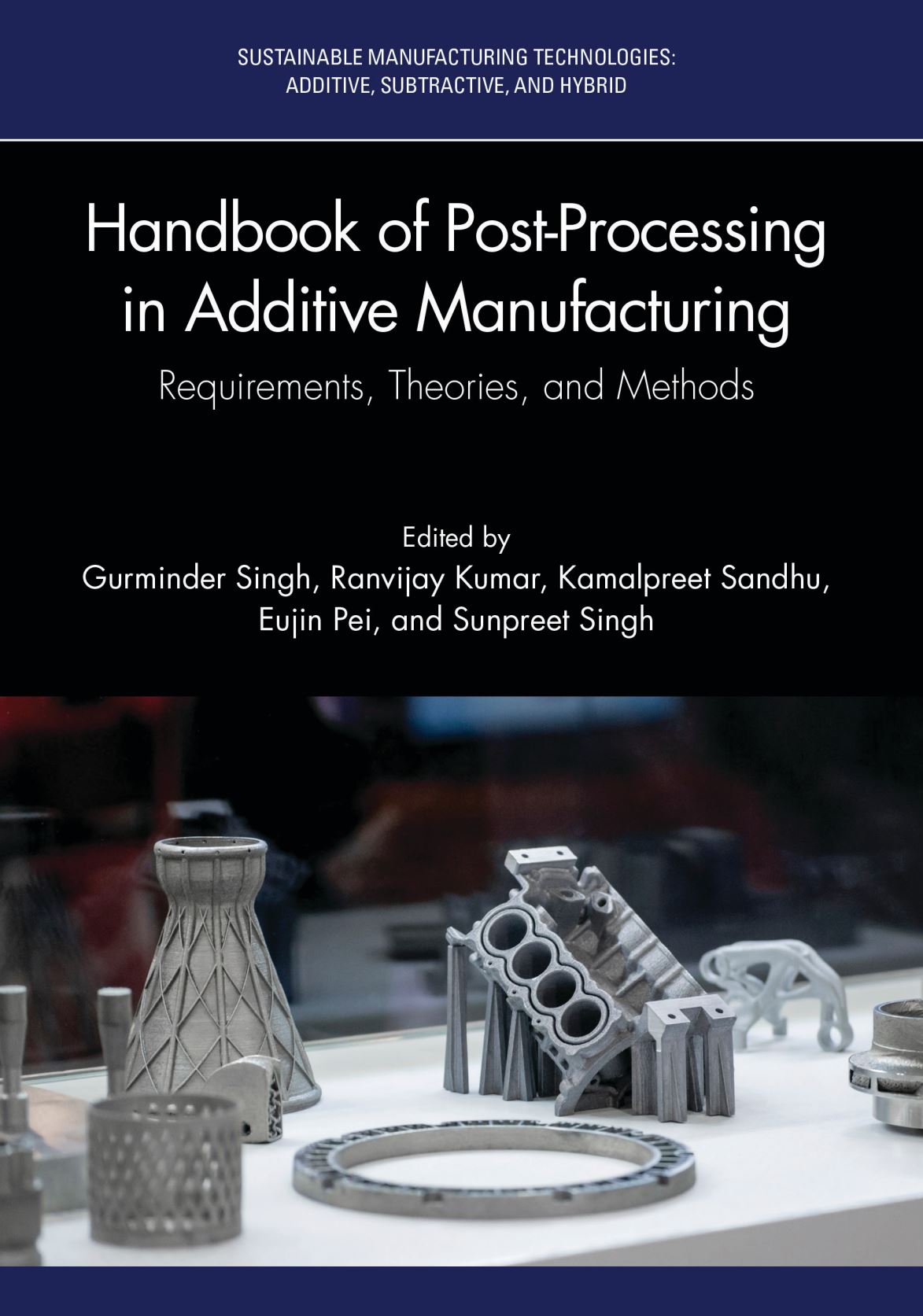Handbook of Post-Processing in Additive Manufacturing – Part 1

Handbook of Post-Processing in Additive Manufacturing
See the new book, edited by Gurminder Singh, Ranvijay Kumar, Kamalpreet Sandhu, Eujin Pei, Sunpreet Singh.
Description: Handbook of Post-Processing in Additive Manufacturing is a key resource on postprocessing treatments available for additive manufactured products. It provides broad coverage of the theory behind emerging technology, material development, functional characterization, and technical details required to investigate novel applications and methods and put them to use.
The handbook presents experimental breakthroughs of novel methodologies that treat additively manufactured parts, which are suitable for demanding engineering applications. This handbook emphasizes the various types of post-processing technologies that can effectively eliminate the inferiorities of additively manufactured components. It also provides a collection of key principles, literature, methodologies, experimental results, case studies, and theoretical aspects of the different types of postprocessing techniques, along with different classes of materials and end-applications.
This book is an ideal reference for libraries and post-graduate courses as well as the professional market, including, but not limited to manufacturing, mechanical and industrial engineering, and materials science.
Chapter 1
Additive manufacturing is referred to as the process of fabrication in which complex, complicated, and customized geometrical structures are fabricated by using the layered deposition methodology. This chapter provides a review of available additive manufacturing techniques, in terms of fundamentals, technologies, recent developments, and their application in several areas. The fundamental process parameters of layer thickness, printing speed, extrusion width, infill angle and pattern, and part orientation influences the mechanical behavior of the component. Laminated object manufacturing is the technique of additive manufacturing in which lamination of the input material fabricate the parts after a successful cutting of the extra material. Schematic diagram represented by using rectangles, circles, and lines to describe the operation of sintering process while layer manufacturing. In selective laser melting, part is fabricated in a layer-by-layer fashion from the fusion of the powder particles under the effect of heat produced via laser light.
Additive Manufacturing Techniques, Fundamentals, Technological Developments, and Practical Applications, ByJasvinder Singh, Ravinder Pal Singh, Pulak Mohan Pandey, Book, Handbook of Post-Processing in Additive Manufacturing, Edition1st Edition, First Published 2023, Imprint CRC Press, Pages34, eBook ISBN9781003276111
Chapter 2
Post-processing is an essential activity between removing parts from an additive manufacturing (AM, more popularly referred to as three-dimensional printing) machine and having it ready for use. This may consist of subtractive manufacturing, thermal treatment, surface modification, and performance assessment to fulfil structural, dimensional, and functional requirements. The post-processing technologies are varied depending on the employment of particular AM technologies, materials, and application expectations. This chapter aims to provide an overview of the inherent limitations and machining strategies for post-processing of AM parts in general practice. Four categories are summarized: removal of powder, support structures, and residual stress; surface modifications; machining accuracy; and mechanical properties improvement. Readers could gain a basic understanding of the common setups, fundamental theory, operational parameters, and applicability of the technologies from this chapter.
An Overview of Post-Processing Technologies in General Practice, ByHaitao Zhu, Allan E.W. Rennie, Yingtao Tian
Book, Handbook of Post-Processing in Additive Manufacturing, Edition1st Edition, First Published 2023, Imprint CRC, Press, Pages 14, eBook ISBN9781003276111
Chapter 4
3D printing has always been seen as a promising technology for creating small, low-quality prototypes. 3D printing involves adding components layer by layer using only raw material and energy source, which is more economical and efficient with materials than cutting a shape from a larger block or pouring molten material into a mold. The commercial market of metal-based additive manufacturing (AM) methods is still dominated by powder bed fusion and directed energy deposition methods. A significant improvement in the overall mechanical and microstructural characteristics of AM products has already been seen after thermal processing. Surface roughness in AM components is dependent on a variety of interrelated factors, including material feedstock, part design, process type, and process parameters. Porosity is a common process-induced AM defect that can be seen in even the best-optimized AM structures.
Post-Processing in Additive Manufacturing, Requirements, Theories, and Methods, By Hamaid Mahmood Khan, Gökhan Özer, Mustafa Safa Yilmaz, Book Handbook of Post-Processing in Additive Manufacturing, Edition1st Edition, First Published 2023, ImprintCRC Press, Pages 24, eBook ISBN9781003276111
See the full book here
Singh, G., Kumar, R., Sandhu, K., Pei, E., & Singh, S. (Eds.). (2023). Handbook of Post-Processing in Additive Manufacturing: Requirements, Theories, and Methods (1st ed.). CRC Press. https://doi.org/10.1201/9781003276111
There will be to addtional articles here soon with the remaining book chapter contents:

